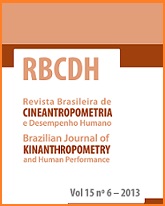Influence of the selection from incremental stages on lactate minimum intensity: a pilot study.
DOI:
https://doi.org/10.1590/1980-0037.2013v15n6p715Abstract
The purposes of this study were to assess the influence of stage selection from the incremental phase and the use of peak lactate after hyperlactatemia induction on the determination of the lactate minimum intensity (iLACmin). Twelve moderately active university students (23±5 years, 78.3±14.1 kg, 175.3±5.1 cm) performed a maximal incremental test to determine the respiratory compensation point (RCP) (initial intensity at 70 W and increments of 17.5 W every 2 minutes) and a lactate minimum test (induction with the Wingate test, the incremental test started at 30 W below RCP with increments of 10 W every 3 minutes) on a cycle ergometer. The iLACmin was determined using second order polynomial adjustment applying five exercise stage selection: 1) using all stages (iLACmin P); 2) using all stages below and two stages above iLACminP (iLACminA); 3) using two stages below and all stages above iLACminP (iLACminB); 4) using the largest and same possible number of stages below and above the iLACminP (iLACminI); 5) using all stages and peak lactate after hyperlactatemia induction (iLACminD). No differences were found between the iLACminP (138.2±30.2 W), iLACminA (139.1±29.1 W), iLACminB (135.3±14.2 W), iLACminI (138.6±20.5 W) and iLACmiD (136.7±28.5 W) protocols, and a high level of agreement between these intensities and iLACminP was observed. Oxygen uptake, heart rate, rating of perceived exertion and lactate corresponding to these intensities was not different and was strongly correlated. However, the iLACminB presented the lowest success rate (66.7%). In conclusion, stage selection did not influence the determination of iLACmin but modified the success rate.



